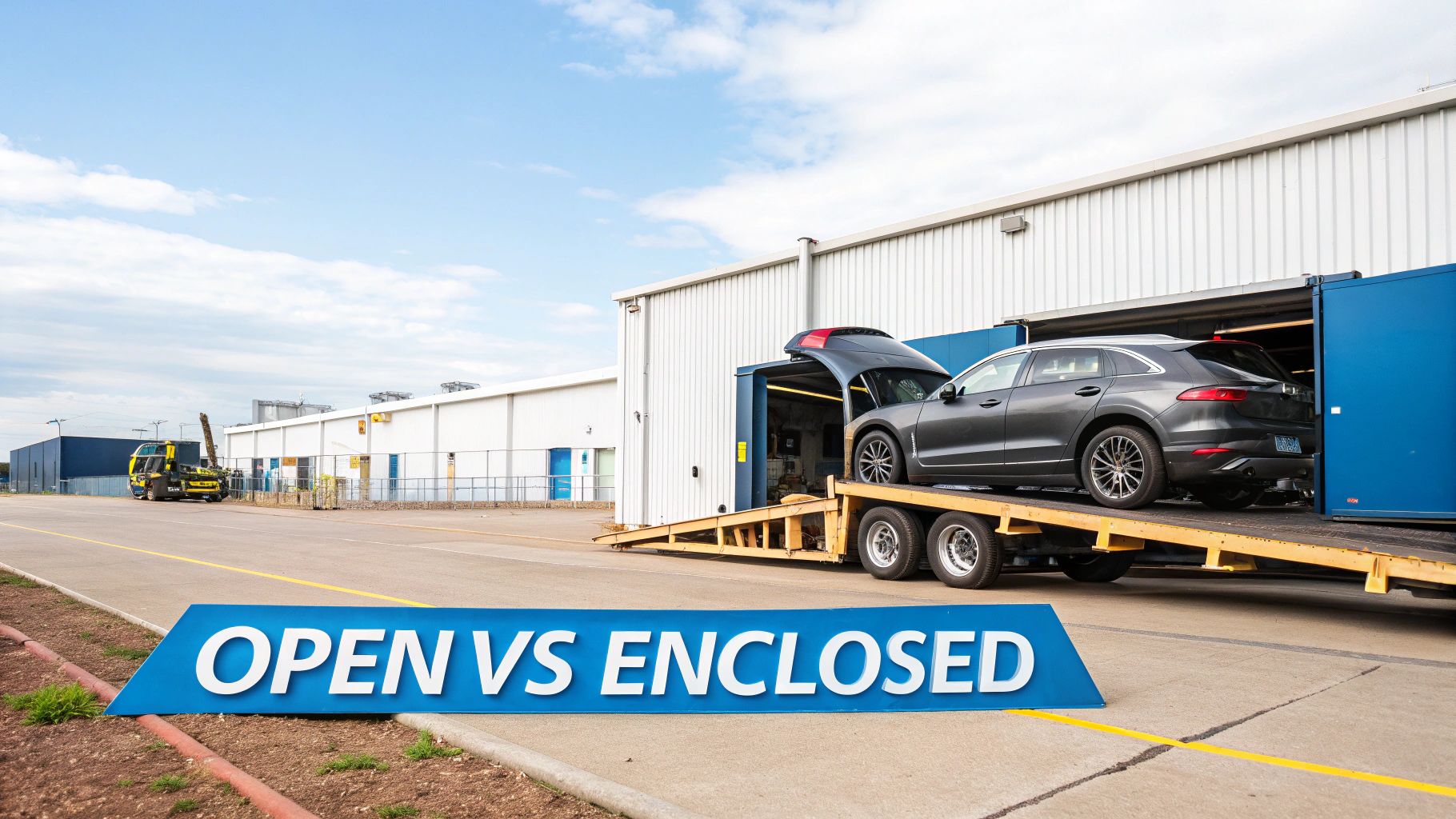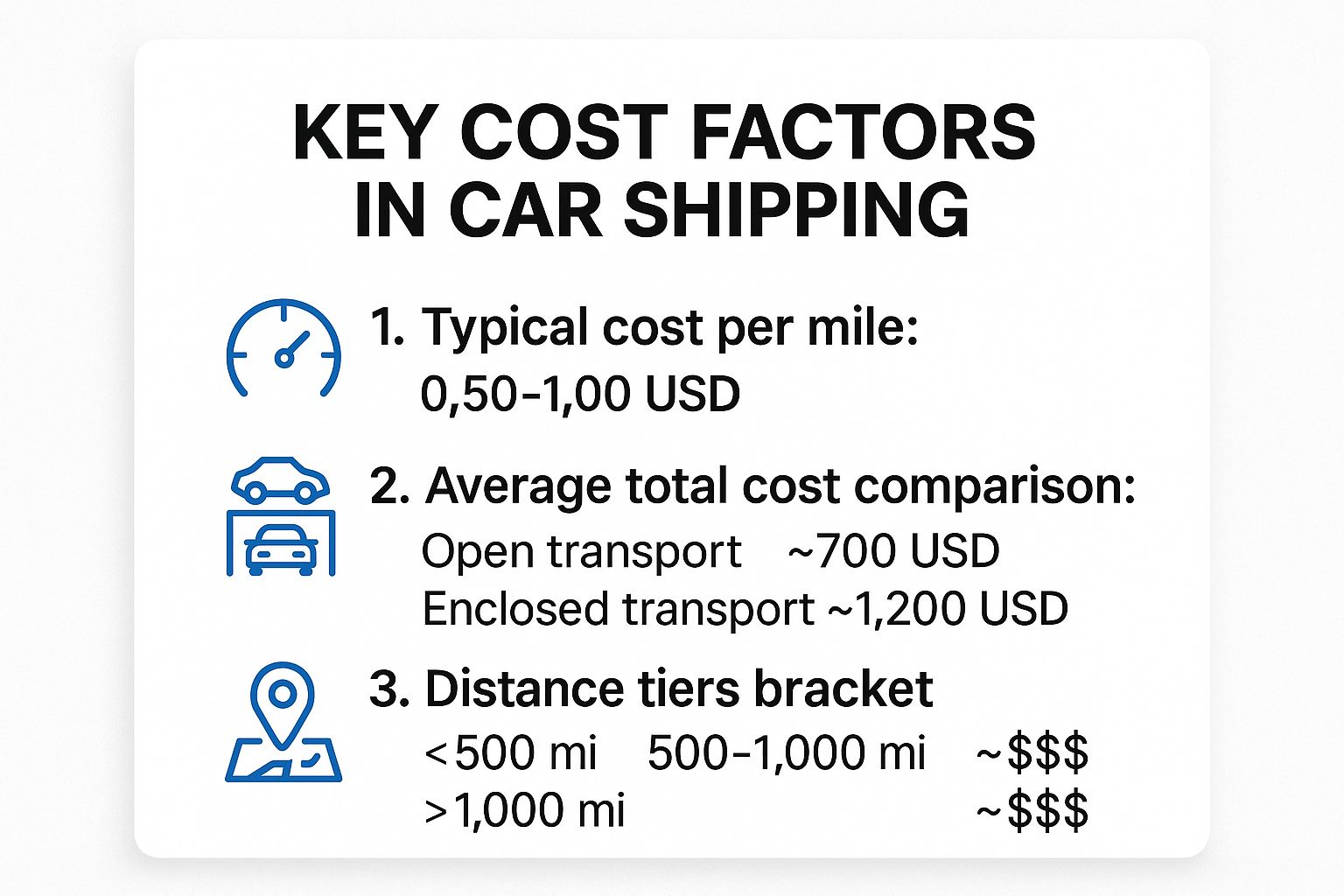
If you're looking for the absolute cheapest way to ship a car, the answer is nearly always open carrier transport. It’s the industry standard for a reason. This method involves loading your vehicle onto an open-air trailer, often with several other cars, which is the key to minimizing your cost.
Your Guide to the Most Affordable Car Shipping Option

When you start gathering car shipping quotes, you'll find open transport is the most common and budget-friendly choice. The logic is simple economics: carriers can load up to 10 vehicles at once, splitting the cost of fuel, insurance, and the driver's time among all the owners. It's a shared-cost model that makes it incredibly affordable.
This isn't a niche service; it's how over 90% of vehicles are shipped. Think of it as the workhorse of the auto transport world. It may not offer premium protection, but it’s a reliable and efficient way to get your car from point A to point B without breaking the bank.
How Open Transport Works
The process is straightforward: a large, often double-decker, truck arrives at your location, and your car is carefully driven onto the trailer and secured for the journey.
The primary trade-off is that your car is exposed to the elements like rain, sun, and road dust, just as it would be if you were driving it yourself. While it's out in the open, the risk of significant damage is low. For a typical shipment, you can expect to pay between $600 and $1,200, though this will vary based on distance, route, and your vehicle's size.
Actionable Insight: For a standard, daily-driver vehicle, the significant cost savings of open transport almost always outweigh the benefit of paying a premium for protection against minor weather exposure.
Choosing between open and enclosed shipping is just one part of the puzzle. To get the full picture, you might want to explore our guide on the different kinds of auto transport services available.
Open vs. Enclosed Transport At a Glance
How does the most affordable option stack up against its premium counterpart? This table breaks down the key differences to help you make a practical decision for your car and budget.
| Feature | Open Transport (Cheapest) | Enclosed Transport (Premium) |
|---|---|---|
| Cost | Significantly lower, often 30-50% cheaper | Higher price point for added service |
| Vehicle Protection | Exposed to weather and road elements | Fully protected in a sealed container |
| Best For | Standard cars, daily drivers, budget moves | Classic cars, luxury vehicles, collectibles |
| Availability | High availability, easier to schedule | Less common, may require more booking time |
Ultimately, for most people just trying to move their primary vehicle, open transport provides the ideal balance of reliability and affordability.
Understanding What Drives Your Final Shipping Price

You've chosen an open carrier—a smart first step for saving money. But what factors determine the final number on your quote? Understanding these variables gives you the power to manage your budget and recognize a fair deal.
The biggest variable is distance. It’s the foundation of your shipping cost, but the pricing model might surprise you. While longer trips cost more overall, the price per mile actually drops the farther your car travels.
This is due to carrier efficiency. The fixed costs of loading, unloading, and paperwork get spread thinner over a longer haul. It’s a classic example of economies of scale at work in the trucking industry.
Actionable Insight: A short trip might have a lower total cost, but the per-mile rate will be higher. For a cross-country move, the carrier operates at peak efficiency, and those savings are passed on to you through a lower per-mile price.
To illustrate with real numbers, recent industry data shows that a short trip under 500 miles can cost $1.60 to $2.60 per mile. For a medium-haul journey between 501 and 1,500 miles, that rate typically falls to around $0.85 to $1.25 per mile. And for long-haul, coast-to-coast trips over 1,500 miles, you’re often looking at $0.60 to $0.95 per mile.
Vehicle Size and Condition
After distance, your car's specifications are the next major factor. A carrier's trailer has limited space and a strict weight limit. A large SUV or a heavy-duty truck will cost more to ship than a compact car.
Consider these two scenarios:
- Scenario A: Shipping a Honda Civic from Miami to New York. It's light, small, and fits easily onto the trailer.
- Scenario B: Shipping a Ford F-150 along the same route. It's significantly heavier and takes up nearly one-and-a-half times the space of a smaller car.
The F-150 will always get a higher quote because it consumes more of the carrier's most valuable asset: space. This applies to length as well—a long, luxury sedan will cost more than a standard hatchback.
Additionally, whether your car is operable matters. A running vehicle can be loaded in minutes. An inoperable car requires special equipment, like a winch, and extra manpower to load it safely. This extra labor always comes with a fee, typically adding $100 to $200 to the final bill. If you want to dive deeper into the numbers, we've put together a full resource detailing the cost to ship a car and all the factors involved.
Your Pickup and Delivery Locations
Where your car is coming from and where it's going has a significant impact on your quote. The auto transport industry thrives on efficiency, and carriers prefer popular, easy-to-access routes.
Shipping a car between two major cities, like Los Angeles and Dallas, is almost always more affordable. These are major trucking corridors with a high volume of drivers, making it easier for them to fill their trailers quickly and keep costs low for everyone.
Conversely, if your pickup or delivery location is in a remote, rural area, expect the price to increase. The driver must make a special detour off the main highway, burning extra fuel and time. This often involves navigating narrow country roads not designed for a massive car hauler.
Pro Tip: To reduce your cost, offer to meet the driver in a nearby city or at a large, accessible parking lot right off the interstate. Making the pickup or drop-off more convenient for the carrier can often shave a meaningful amount off your final quote.
Use Your Calendar to Find the Cheapest Rates

When seeking the best deal on car shipping, your calendar is one of your most powerful tools. The auto transport industry operates on supply and demand, and strategic planning can save you a significant amount of money.
If you can be flexible with your dates, you give carriers the leeway they need to fit your vehicle into their existing routes efficiently. This logistical efficiency often translates directly into a lower price for you.
Ride the Seasonal Waves for Better Pricing
Just like air travel, car shipping has peak and off-seasons. The summer months, from May through September, are the busiest and most expensive. This period sees high demand from college students, families moving before the school year, and military personnel making their PCS (Permanent Change of Station) moves.
With high demand, space on trailers becomes a premium commodity, and prices rise. If your timeline allows, aim for the industry's off-season.
- Fall (October – November): As the summer rush subsides, so do prices. This is an excellent window to find more competitive quotes.
- Winter (December – February): This is typically the quietest time of year. With fewer people moving, carriers are eager to fill their trucks, often leading to the best deals. Be aware that severe weather in northern states can cause delays.
- Spring (March – April): Rates begin to climb as the weather improves, but it's still more affordable than the peak summer season.
The only exception is major holidays. Shipping a car around Christmas or New Year's can be as expensive as shipping in July due to fewer available drivers.
Actionable Insight: I've seen clients save 10-20% on their shipping cost just by shifting their shipment from July to October. On a cross-country trip, that could easily be a couple of hundred dollars back in your pocket.
How a Flexible Schedule Saves You Real Money
One of the most effective ways to lower your shipping cost is to provide the carrier with a flexible pickup window. Demanding a specific, fixed pickup date forces them to arrange a special trip, which comes with an expedited service fee.
Instead, inform the shipping company that you have a 5-7 day window for pickup. This is a game-changer for the dispatcher. It allows them to slot your car onto a truck that's already scheduled to pass through your area, filling an otherwise empty spot and avoiding a costly detour.
They save on logistics, and you save on the price. It's a simple trade-off: your flexibility for a better rate.
Finding the Sweet Spot: Booking Ahead vs. Last-Minute
It’s a common misconception that booking your car shipment months in advance guarantees the lowest price. In reality, most carriers don't finalize their routes that far out, and a quote given three months early is just an estimate that could change.
The ideal time to book is about 2-4 weeks before your desired pickup date. This gives the broker or carrier enough time to coordinate and find the right truck at a competitive price without the pressure of a last-minute request.
Conversely, needing a car moved "tomorrow" is the fastest way to pay a premium. Urgent requests force dispatchers to find a driver willing to make an immediate pickup, and that driver can command a higher price. A little planning is the best way to avoid these hefty last-minute surcharges.
How to Find and Vet Affordable Shipping Companies
Getting a low price on auto shipping is one thing, but finding a reliable company that honors that quote is the real challenge. The cheapest way to ship a car involves detective work to distinguish genuine deals from risky, lowball offers that can lead to problems later.
Start by casting a wide net. Use online auto transport marketplaces to get multiple bids from a single request. This forces companies to compete for your business, which helps drive down initial prices.
Once quotes arrive, don't just grab the lowest number. An unusually cheap quote is often a red flag, potentially indicating a less-than-reputable operator who might surprise you with hidden fees or poor service.
To give you a better sense of how costs break down, take a look at this.

As you can see, factors like distance and transport type (open vs. enclosed) make a huge difference. This is why getting multiple, detailed quotes is essential for finding a genuinely affordable price.
Digging Deeper Than the Initial Quote
Once you have a few promising quotes, it's time to vet these companies. A great price is worthless if the carrier is uninsured or unreliable.
First, verify their legal status. Every legitimate auto transport broker and carrier must be registered with the Federal Motor Carrier Safety Administration (FMCSA). You should look up any company on the FMCSA website using their USDOT or MC number. This confirms they are authorized for hire and provides access to their safety and insurance records.
Crucial Tip: Never book with a company that doesn't have an active FMCSA registration. This is non-negotiable and your primary defense against fraudulent operators.
Next, verify their insurance. Request a copy of their Certificate of Insurance. Any reputable provider will supply this without hesitation. Confirm that the coverage amount is sufficient for your vehicle's value and that the policy is active. Don't just take their word for it; review the document yourself. This is a vital step in learning how to find a good car shipping service that protects your asset.
Scouring Reviews and Checking Reputations
With legal and insurance requirements met, find out what past customers are saying. A company’s own website will only show positive testimonials, so turn to independent, third-party review sites for an unbiased view.
Check platforms like the Better Business Bureau (BBB), Google Reviews, and TransportReviews.com. Focus on recent reviews and look for patterns. Are multiple people complaining about the same issues, like constant delays, poor communication, or surprise charges? These are significant warning signs.
Also, note how a company responds to negative feedback. A professional and active response to complaints shows they value customer service. A wall of ignored complaints is a clear sign to look elsewhere.
Use this checklist to evaluate each potential shipping company and ensure you don't miss any critical steps.
Vetting Checklist for Car Shipping Companies
| Verification Step | What to Look For | Why It Matters |
|---|---|---|
| FMCSA Registration | Active USDOT and/or MC number on the FMCSA website. | Confirms the company is legally authorized to operate and isn't a scam. |
| Insurance Certificate | A current Certificate of Insurance with adequate cargo coverage for your car's value. | Protects you financially in case of damage during transit. Verbal confirmation isn't enough. |
| Online Reviews | Consistent positive feedback on sites like BBB, Google, and TransportReviews.com. | Reveals real-world customer experiences with communication, timeliness, and pricing accuracy. |
| Complaint Response | Professional and proactive responses to negative reviews. | Shows the company values customer service and takes responsibility for issues. |
| Quote Inclusions | A detailed, all-inclusive quote that specifies what is covered. | Helps you avoid hidden fees for things like fuel surcharges or insurance. |
| Contract Terms | Clear language on cancellation policies, payment schedules, and damage claims. | Ensures you understand your rights and obligations before signing. |
By systematically working through this checklist, you can move beyond just price and make an informed decision based on reliability and trustworthiness.
Comparing Apples to Apples
Finally, lay out your top quotes side-by-side to ensure you're making a fair comparison. A quote might look cheap initially, but the details matter.
- Insurance: Is full cargo insurance included, or is it an extra fee?
- Fuel Surcharges: Are these included in the price, or will they be added later?
- Service Type: Does the price reflect door-to-door service or the less convenient terminal-to-terminal option?
For example, a low-cost provider might advertise a per-mile rate of $0.72 for open transport. However, these rates are just a starting point. Only by comparing detailed, final quotes for your specific trip can you see the true cost differences between companies. This level of scrutiny ensures you find a company that is not just cheap, but also transparent and dependable.
Getting Your Car Ready for a Smooth Handover
https://www.youtube.com/embed/Tva_wPmDUwQ
Prepping your car for pickup isn't just about making the driver's job easier; it's a critical step to prevent surprise fees and potential disputes. A small amount of preparation ensures the entire process goes smoothly and that the price you were quoted is the price you pay.
These simple tasks protect you, your vehicle, and the shipping company by streamlining the inspection, lowering the risk of damage, and ensuring compliance with transport regulations.
Your Pre-Shipment Checklist
Before you hand over the keys, conduct a thorough pre-shipment check.
First, wash your car. It may seem counterintuitive before a long trip, but it's essential for the inspection. A clean car allows you and the driver to easily spot and document every existing scratch, ding, and dent.
Actionable Insight: This is your proof. A clean car leads to an accurate inspection report, which is your primary evidence if you need to file a damage claim later. Without proof that a dent wasn't there before pickup, getting it covered will be difficult.
Next, remove all personal items. This includes phone chargers, sunglasses, documents, and any loose items in the trunk. Auto carriers are not licensed to transport household goods, and their insurance will not cover your personal belongings. If anything is lost, stolen, or damaged, you will not be compensated.
Fuel, Fluids, and a Quick Mechanical Check
Your fuel level matters. Run the tank down to about one-quarter full. This provides plenty of fuel for the driver to load and unload the vehicle while helping to reduce its overall weight.
In the shipping industry, every pound counts. While a full tank of gas alone may not trigger an extra fee, it adds to the carrier’s total cargo weight, which is tightly regulated. A lighter car is always better for transport.
While you're at it, perform a quick mechanical check:
- Tire Pressure: Ensure all tires are inflated to the recommended PSI.
- Leaks: Check underneath for any fluid drips. A carrier can refuse to load a vehicle that is actively leaking oil or coolant.
- Battery: Confirm the battery is charged and the terminals are secure.
If your car needs minor repairs, it's best to handle them beforehand. You can always find quality auto repair services to address any pre-shipping needs.
Don't Skip the Bill of Lading
The most important document in this process is the Bill of Lading (BOL). This is not just a receipt; it is a legally binding contract between you and the carrier.
When the driver arrives, you will conduct a walk-around inspection together. Every single scuff, scratch, and dent must be documented on the BOL's condition report. Be meticulous. Do not sign anything until you have personally inspected the car with the driver and agree with all notations.
This document serves two critical functions:
- The Official Condition Report: It's the "before" picture of your car's condition.
- The Contract: It outlines all terms of the shipment.
Upon delivery, you will repeat this inspection, comparing the car's current state to the original notes on the BOL. If you find any new damage, it must be noted on the final paperwork before you sign. This document is what turns a potential dispute into a straightforward claim.
Answering Your Top Car Shipping Questions
Even after thorough research, a few questions often remain when you're trying to find the cheapest way to ship a car. Addressing these common concerns can impact your final cost and provide valuable peace of mind.
One of the biggest questions is whether it's simply cheaper to drive the car yourself. While it seems like an obvious way to save money, the true costs can be surprisingly high, especially for long-distance moves.
Is It Really Cheaper to Drive or Ship My Car?
For a short trip of a few hundred miles, driving is almost always the more economical choice. However, for a cross-country move, the math often favors shipping. The cost of driving extends far beyond fuel.
When you drive, you must account for:
- Gas: A coast-to-coast trip can require multiple fill-ups.
- Hotels: Several nights in motels can add hundreds of dollars to your budget.
- Food & Drinks: Eating on the road for several days adds up quickly.
- Lost Wages: The days spent driving are days you're not working.
- Wear and Tear: A long trip adds thousands of miles to your car, accelerating depreciation and bringing your next major maintenance bill closer.
A long drive can easily exceed $1,200 in direct costs, without even valuing your time. When you compare that to an open transport quote, you may find that shipping is not only cheaper but also saves you days of stress and fatigue.
Can I Pack My Car Full of My Stuff?
It’s tempting to use your car as a personal moving container, but this is a mistake that can lead to major issues. Nearly every auto transporter prohibits personal belongings in the car for several important reasons.
First, Department of Transportation (DOT) regulations forbid carriers from hauling household goods inside a vehicle they are shipping. More importantly, items packed in your car are not covered by the carrier’s cargo insurance. If your belongings are lost, damaged, or stolen, you have no recourse.
Practical Advice: The insurance policy covers one specific item: your car. It does not cover an unlisted assortment of boxes. The extra weight can also affect the transport truck's balance and may result in overweight fees.
Some carriers may permit a single suitcase in the trunk weighing less than 100 pounds, but you must get this exception approved in writing on your contract before pickup. Never assume it's allowed.
Do I Have to Be There for Pickup and Delivery?
While you don't personally have to be present, someone must be. You can designate a trusted friend, family member, or neighbor to act as your agent for both pickup and delivery.
The key is to ensure your designated person understands their responsibilities. They are not just handing over the keys; their primary role is to conduct the vehicle inspection with the driver and sign the Bill of Lading.
This document is your official record—a legally binding contract that notes the car's condition at pickup and drop-off. Your representative must be prepared to perform a thorough inspection and document everything carefully.
What Happens If My Car Is Damaged During Shipping?
While damage is rare with reputable carriers, accidents can happen. This is why carriers are required by law to have insurance. If you notice new damage upon delivery, remain calm and be systematic.
Document the damage directly on the Bill of Lading before you sign it and before the driver leaves. This is the single most important step. Once you sign a clean report, proving the damage occurred during transit becomes extremely difficult.
Follow this action plan:
- Write down every new scratch, dent, or scuff directly on the Bill of Lading.
- Take clear, well-lit photos of the damage from multiple angles.
- Have the driver acknowledge the notes you've made, if possible.
- Contact the shipping company immediately to initiate the claims process.
Your detailed notes and photos on the Bill of Lading are your primary evidence. A thorough inspection at both ends of the journey is your best form of protection.
Figuring out auto transport can feel like a lot, but with the right team, it doesn't have to be a headache. For a smooth experience backed by years of hands-on expertise, let We Will Transport It handle your vehicle with the care it deserves. Get your free, no-obligation quote today and discover just how easy shipping your car can be.





